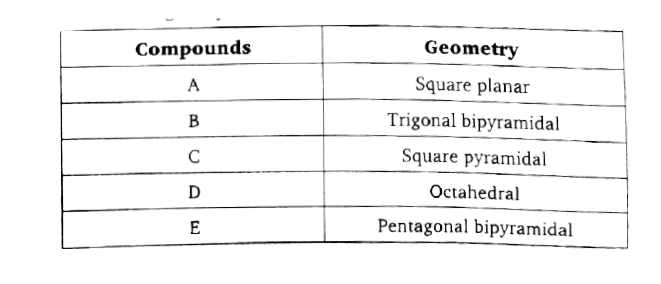If two different non-axial d-orbitals having 'xz' nodal plane form π-bond by overlapping each other, then internuclear axis will be :
x
y
z
They don't form π-bond
The correct Answer is:D
To solve the problem, we need to analyze the given information about the non-axial d-orbitals and their nodal planes. Here’s a step-by-step solution:
Step 1: Identify Non-Axial d-Orbitals
The non-axial d-orbitals are dxy, dyz, and dxz. These orbitals are characterized by their orientation in relation to the axes of the coordinate system.
Hint: Remember that non-axial d-orbitals do not point directly along the x, y, or z axes.
Step 2: Understand the Nodal Plane
The question specifies that the d-orbitals have an 'xz' nodal plane. This means that the wave function of the orbitals has a node (a region of zero probability) in the xz plane, which affects their orientation and overlap.
Hint: Visualize the nodal plane as a flat surface where the probability of finding an electron is zero.
Step 3: Draw the Orbitals
Draw the dxy and dyz orbitals to visualize their shapes and orientations. The dxy orbital lies in the xy plane, while the dyz orbital lies in the yz plane.
Hint: Sketching the orbitals can help you see how they relate to the xz nodal plane.
Step 4: Analyze Overlap for Pi Bonding
For pi bonding to occur, the orbitals must overlap side by side. However, since the dxy and dyz orbitals are perpendicular to each other, they cannot overlap effectively to form a pi bond.
Hint: Remember that only orbitals aligned in the same plane can overlap to form pi bonds.
Step 5: Conclude the Internuclear Axis
Since the dxy and dyz orbitals are perpendicular and cannot form a pi bond, there is no internuclear axis that allows for such bonding. Therefore, the answer to the question is that no pi bond formation occurs.
Hint: Consider the implications of perpendicular orbitals in terms of bonding capabilities.
Final Answer
The internuclear axis will be such that no pi bond can be formed due to the perpendicular nature of the orbitals involved.
The non-axial d-orbitals are dxy, dyz, and dxz. These orbitals are characterized by their orientation in relation to the axes of the coordinate system.
The question specifies that the d-orbitals have an 'xz' nodal plane. This means that the wave function of the orbitals has a node (a region of zero probability) in the xz plane, which affects their orientation and overlap.
Draw the dxy and dyz orbitals to visualize their shapes and orientations. The dxy orbital lies in the xy plane, while the dyz orbital lies in the yz plane.
For pi bonding to occur, the orbitals must overlap side by side. However, since the dxy and dyz orbitals are perpendicular to each other, they cannot overlap effectively to form a pi bond.
Since the dxy and dyz orbitals are perpendicular and cannot form a pi bond, there is no internuclear axis that allows for such bonding. Therefore, the answer to the question is that no pi bond formation occurs.
The internuclear axis will be such that no pi bond can be formed due to the perpendicular nature of the orbitals involved.
Topper's Solved these Questions
- BOOK - VK JAISWAL ENGLISHCHAPTER - CHEMICAL BONDING (BASIC)EXERCISE - Level 3 (Passive 1)6videos
CHEMICAL BONDING (BASIC)
- BOOK - VK JAISWAL ENGLISHCHAPTER - CHEMICAL BONDING (BASIC)EXERCISE - Level 3 (Passive 2)6videos
CHEMICAL BONDING (BASIC)
- BOOK - VK JAISWAL ENGLISHCHAPTER - CHEMICAL BONDING (BASIC)EXERCISE - SUBJECTIVE PROBLEMS54videos
CHEMICAL BONDING (BASIC)
- BOOK - VK JAISWAL ENGLISHCHAPTER - CHEMICAL BONDING (ADVANCED)EXERCISE - SUBJECTIVE PROBLEMS64videos
CHEMICAL BONDING (ADVANCED)
- BOOK - VK JAISWAL ENGLISHCHAPTER - CO-ORDINATION COMPOUNDSEXERCISE - LEVEL 2144videos
CO-ORDINATION COMPOUNDS
Similar Questions
py-orbital can not form π -bond by lateral overlap with :
View Solutionpy-orbital can not form π -bond by lateral overlap with :
View SolutionWhich molecular orbital of O2 have a nodal plane which is perpendicular to internuclear axis
View SolutionWhen two co-axial coils having same current in same direction are bring to each other, then the value of current in both coils:
View SolutionConsider the following compounds with their regular geometries.

Calculate value of (x+y−z)2, where x is total number of axial d-orbitals having zero nodal plane, y and z are total no. of non-axial and axial d-orbitals respectively each one having two nodal planes used in hybridisation of central atoms of compounds A to E.View SolutionConsider the following compounds with their regular geometries.

Calculate value of (x+y−z)2, where x is total number of axial d-orbitals having zero nodal plane, y and z are total no. of non-axial and axial d-orbitals respectively each one having two nodal planes used in hybridisation of central atoms of compounds A to E.View SolutionWhich of the following overlaps of atomic orbitals does not form π-bond if z-axis is the internuclear axis?
View SolutionWhich of the following molecular orbital has two nodal planes perpendicular to each other?
View SolutionIn which of the following species, d-obitals having xz an yz two nodal planes involved in hybridization of central atoms?
View SolutionAssertion:- If dx2y2 and py orbitals come close together along z-axis, then can form π−bond by sideways overlapping.
Reason:- Both orbitals do not have electron density along z-axis.View Solution

